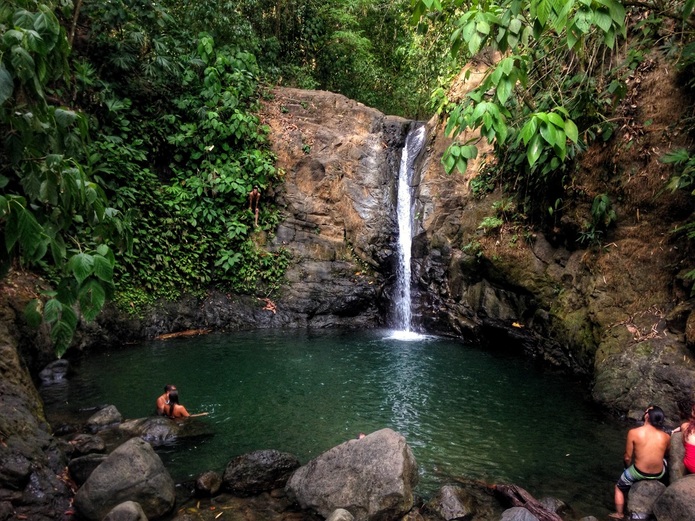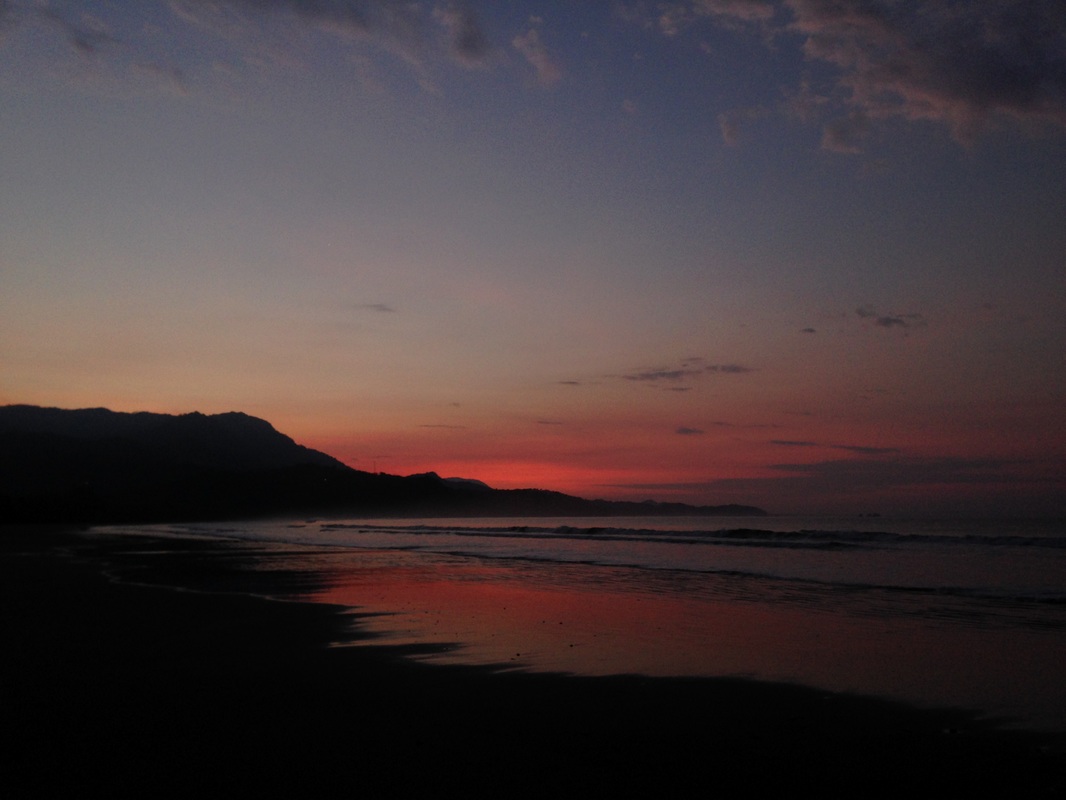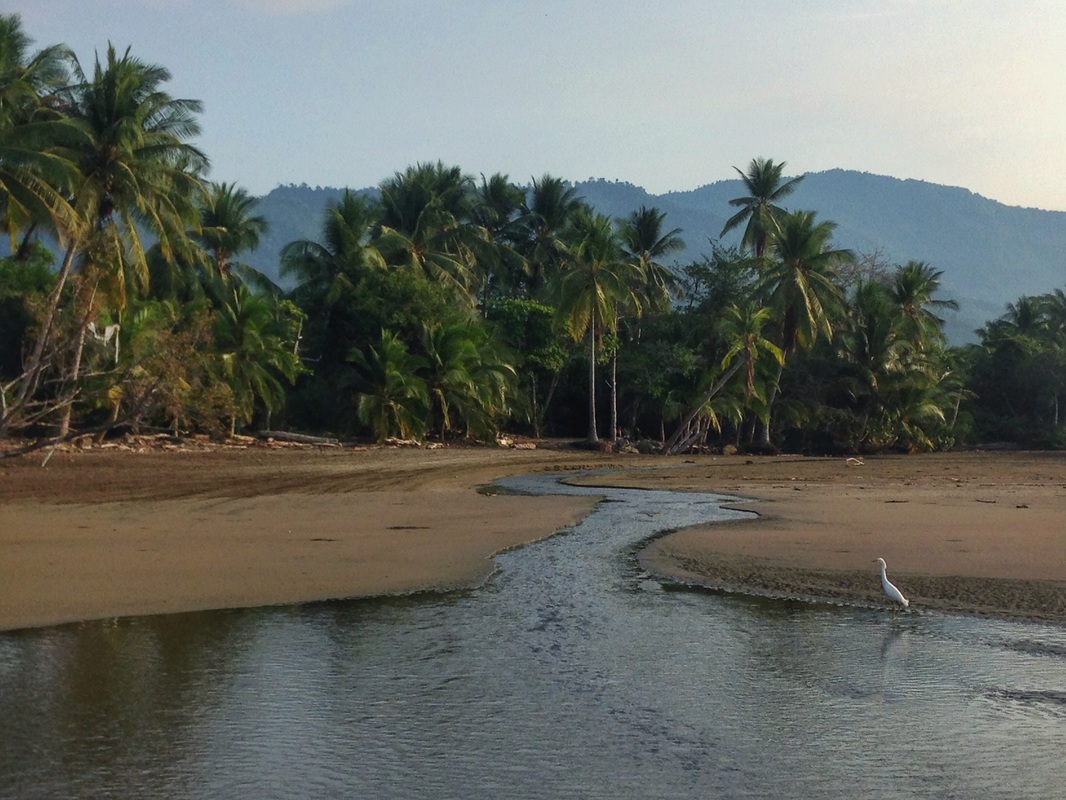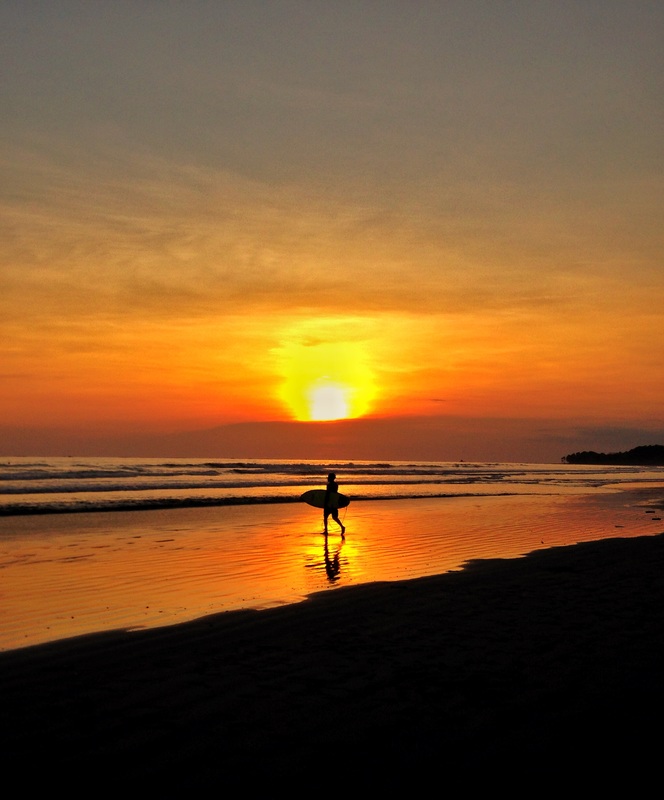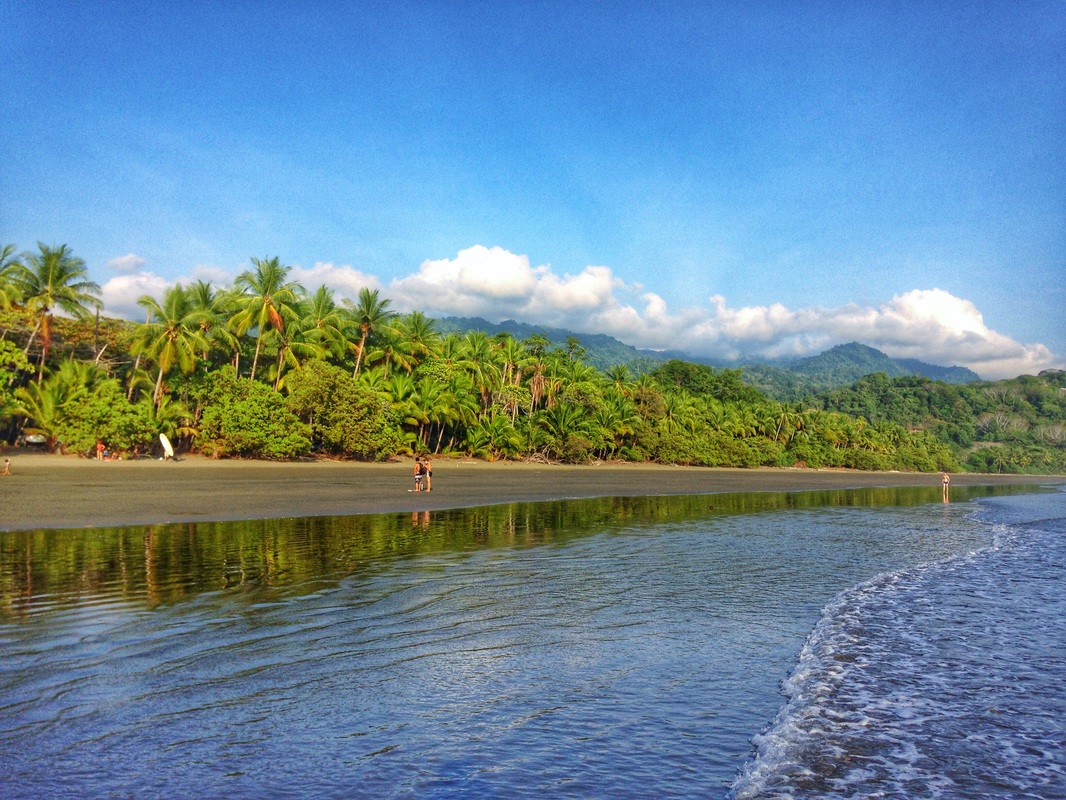By: Dylan Jones
Adventure Scientist
Adventure Scientist
White sand gives softly under our feet, reflecting enough ambient light to illuminate the empty beach and rolling boils of big surf. The crescendo of crashing waves makes the black expanse of the Pacific sound as if it is breathing, possessing the power and will of a sentient being. The plethora of tropical birds that populate the Parque Nacional Marino Ballena is still resting—their beautiful songs won’t be carried along the salty wind until the searing equatorial sun crests the coastal mountains.
The tide is rising, and we have to make it out to the ‘whale tail’ and back before the thrashing waters inundate the narrow land bridge granting our passage to the famous rocky outcrop. Sitting just nine degrees north of the equator, the sun rises early here. Brilliant magenta hues began to bleed across the sky over the densely forested peaks, revealing a meandering drift of clouds. Frozen in awe, I forget that time is of the essence. In fact, time ceases to exist. The scale of the surreal scene makes it feel as if we stand on the shores of the cosmic ocean, peering into the vast and unfathomable expanse of space-time.
We make it to the tail just in time to watch our nuclear furnace ignite a new day in paradise. As we hustle back to the mainland, the tide splashes our shins. Looking back at the tail, I shudder at the idea of being stranded waiting for the tide to recede—surely it’s happened to someone. Knowing I won’t be that unfortunate soul, I release a deep breath and say the words out loud: Welcome to Costa Rica.
Pura Vida. Literally translated, the Costa Rican motto means pure life. But the Tico turn of phrase is more than an expression—it’s a laid back life philosophy. The concept seemed appropriate for my continued involvement in Adventurers and Scientists for Conservation’s Global Microplastics Initiative, an ongoing study that seeks to identify the sources, composition and distribution of microplastics in marine and freshwater environments.
Pura Vida. Literally translated, the Costa Rican motto means pure life. But the Tico turn of phrase is more than an expression—it’s a laid back life philosophy. The concept seemed appropriate for my continued involvement in Adventurers and Scientists for Conservation’s Global Microplastics Initiative, an ongoing study that seeks to identify the sources, composition and distribution of microplastics in marine and freshwater environments.
My trip to Costa Rica represented my fourth outing as an adventure scientist. Having participated with ASC over four years, I am committed to making each of my adventurers bigger than myself. I collected salt water samples in 2015 during a climbing trip through Southeast Asia, and I jumped at the opportunity to collect freshwater samples in one of the world’s most pristine tropical environments.
Nearly a quarter of Costa Rica’s lands are permanently protected as national parks or other designations. Although it claims only one tenth of one percent of the world’s land mass, it contains five percent of the planet’s biodiversity. That includes essential pollinators, a brilliant array of fruits and vegetables, and rainforests teeming with medicinal value. It quickly becomes apparent how vital the region is to our viability in a decreasingly diverse world. Costa Rica is lauded for its progressive environmental policies—in 2012, it ranked fifth in the world on the United Nations Environmental Performance Index.
But while Costa Rica may be touted as one of the cleanest countries, it has been enjoying an expanding economy, complete with controversial palm oil plantations. These monoculture farms greatly reduce biodiversity and quickly deplete the rich volcanic soils needed to support native biomes.
Nearly a quarter of Costa Rica’s lands are permanently protected as national parks or other designations. Although it claims only one tenth of one percent of the world’s land mass, it contains five percent of the planet’s biodiversity. That includes essential pollinators, a brilliant array of fruits and vegetables, and rainforests teeming with medicinal value. It quickly becomes apparent how vital the region is to our viability in a decreasingly diverse world. Costa Rica is lauded for its progressive environmental policies—in 2012, it ranked fifth in the world on the United Nations Environmental Performance Index.
But while Costa Rica may be touted as one of the cleanest countries, it has been enjoying an expanding economy, complete with controversial palm oil plantations. These monoculture farms greatly reduce biodiversity and quickly deplete the rich volcanic soils needed to support native biomes.
We took a break from euphoric sunset surf sessions to find the Uvita waterfall, a paradisiacal swimming hole where locals and tourists escape the stifling daytime heat and practice pura vida. As I collected my samples, I thought back to Southeast Asia—of the three marine samples I gathered, one was completely free of microplastics, joining a small percentage of samples able to make such a claim. Despite the pristine appearance of the deep green pool, the popularity of the Uvita waterfall left me skeptical of a second plastic-free sample.
On the bus from Uvita to the capital city bustle of San Jose, we passed countless hectares of oil palms. The uniform rows blended into a steady stream of green and brown. A processing plant coughed black smoke into the evening air as rickety trucks transported burgeoning loads of palm fruit bunches. Some of the extracted oil will most certainly end up in products packaged in plastic.
As the bus climbed from the coastal flats into rugged mountains, the driver careened around hairpin turns with a casual attitude. I noticed a girl in front of me wearing a tank top with Pura Vida printed in neon green. I wondered how many tourists explore what the phrase represents beyond its satisfying linguistic flow and simple literal translation. How many of them are aware of the omnipresence of microplastics—the pygmy elephant in the room?
On the bus from Uvita to the capital city bustle of San Jose, we passed countless hectares of oil palms. The uniform rows blended into a steady stream of green and brown. A processing plant coughed black smoke into the evening air as rickety trucks transported burgeoning loads of palm fruit bunches. Some of the extracted oil will most certainly end up in products packaged in plastic.
As the bus climbed from the coastal flats into rugged mountains, the driver careened around hairpin turns with a casual attitude. I noticed a girl in front of me wearing a tank top with Pura Vida printed in neon green. I wondered how many tourists explore what the phrase represents beyond its satisfying linguistic flow and simple literal translation. How many of them are aware of the omnipresence of microplastics—the pygmy elephant in the room?
I considered the one molecule that provides the foundation for pure life—water. Although we can’t see microplastics, water tainted with these toxic particles is no longer pure.
The crystal clear bays in Thailand and the vibrant waterfalls in Costa Rica may not be as they appear. A more pure approach to life by humans can certainly alleviate future pollution while we figure out how to remediate existing damage.
As we sat in the San Jose airport awaiting our flight to the states, I saw the phrase again, painted on a brick wall. Like the water cycle, it had all come full circle. Pura Vida. What better phrase to embody the end goal of the Global Microplastics Initiative?
The crystal clear bays in Thailand and the vibrant waterfalls in Costa Rica may not be as they appear. A more pure approach to life by humans can certainly alleviate future pollution while we figure out how to remediate existing damage.
As we sat in the San Jose airport awaiting our flight to the states, I saw the phrase again, painted on a brick wall. Like the water cycle, it had all come full circle. Pura Vida. What better phrase to embody the end goal of the Global Microplastics Initiative?
Learn more about the Global Microplastics Initiative and other ASC projects on our website, the Field Notes blog, and our Facebook, Twitter, Instagram and Google+ pages.

